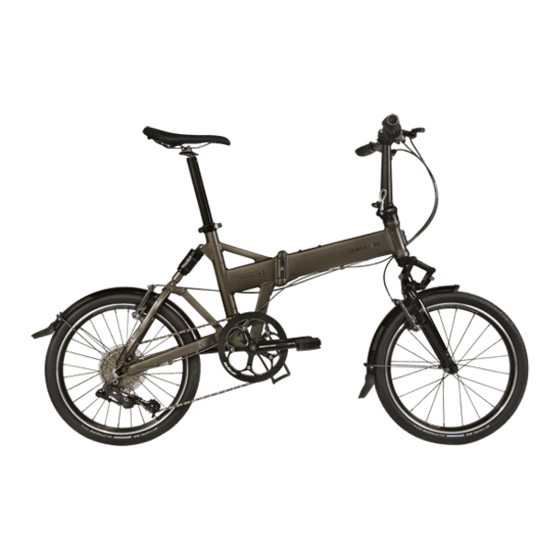DAHON - 2010 소유자 매뉴얼 - 페이지 14
{카테고리_이름} DAHON - 2010에 대한 소유자 매뉴얼을 온라인으로 검색하거나 PDF를 다운로드하세요. DAHON - 2010 20 페이지.
DAHON - 2010에 대해서도 마찬가지입니다: 매뉴얼 (2 페이지), 매뉴얼 (2 페이지), 매뉴얼 (2 페이지), 매뉴얼 (2 페이지), 매뉴얼 (2 페이지), 매뉴얼 (2 페이지)

Service
WARNING: Technological advances
have made bicycles and bicycle
components more complex, and the pace of
innovation is increasing. It is impossible for
this manual to provide all the information
required to properly repair and/or maintain
your bicycle. In order to help minimize the
chances of an accident and possible injury,
it is critical that you have any repair or
maintenance that is not specifically
described in this manual performed by your
dealer. Equally important is that your
individual maintenance requirements will be
determined by everything from your riding
style to geographic location. Consult your
dealer for help in determining your mainte-
nance requirements.
WARNING: Many bicycle service and
repair tasks require special knowl-
edge and tools. Do not begin any adjust-
ments or service on your bicycle until you
have learned from your dealer how to
properly complete them. Improper adjust-
ment or service may result in damage to the
bicycle or in an accident that can cause
serious injury or death.
14
Service Intervals
Some service and maintenance can and should
be performed by the owner, and requires no
special tools or knowledge beyond what is pre-
sented in this manual.
The following are examples of the type of
service you should perform yourself. All other
service, maintenance and repair should be per-
formed in a properly equipped facility by a qual-
ified bicycle mechanic, using the correct tools
and procedures specified by the manufacturer.
Break-in Period
Your bike will last longer and work better if
you break it in before riding it hard. Control
cables and wheel spokes may stretch or "seat"
when a new bike is first used and may require
readjustment by your dealer. Your Mechanical
Safety Check will help you identify some things
that need readjustment. But even if every-
thing seems fine to you, it is best to take your
bike back to the dealer for a checkup. Dealers
typically suggest you bring the bike in for a
30-day checkup. Another way to judge when it
is time for the first checkup is to bring the bike
in after three to five hours of hard off-road use,
or about 10 to 15 hours of on-road or more
casual off-road use. But if you think something
is wrong with the bike, take it to your dealer
before riding it again.
After Every Long or Hard Ride
If the bike has been exposed to water or grit,
or at least every 100 miles, clean it by wiping it
clean and lightly oil the chain with a dry Teflon
lubrication or a synthetic based chain lube.
Then, very importantly, wipe off excess oil.
Long lasting lubrication is a function of climate.
(Hot or cold, wet or dry.) For general cycle
lubrication, Dahon suggests using lightweight
mineral based oil that is commonly available
in most bike shops or hardware stores. If you
have any questions, please talk to your dealer
as an incorrect lubricant can damage the
painted surfaces.
After Every Long or Hard Ride or After
Every 10 to 20 Hours of Riding
Squeeze the front brake and rock the bike
forward and back. If you feel a clunk with each
forward or backward movement of the bike,
you probably have a loose headset. Have your
dealer check it.
Lift the front wheel off the ground and swing
it from side to side. If you feel any binding or
roughness in the steering, you may have a tight
headset. Have your dealer check it.
Grab one pedal and rock it toward and away
from the centerline of the bike; then do the
same with the other pedal. Anything feel loose?
If so, have your dealer check it.
